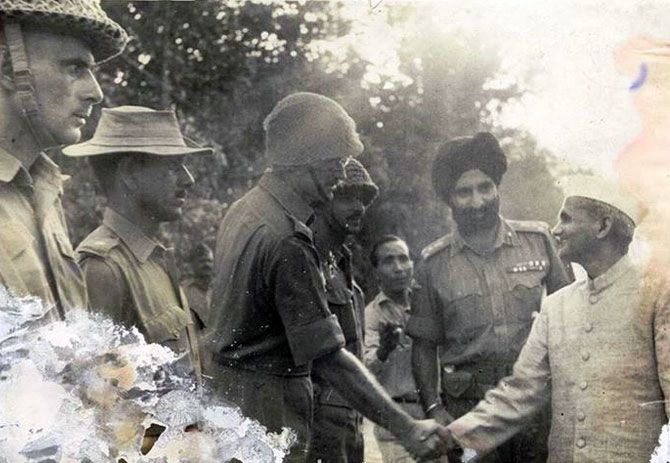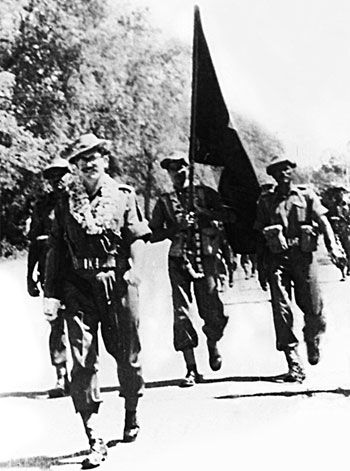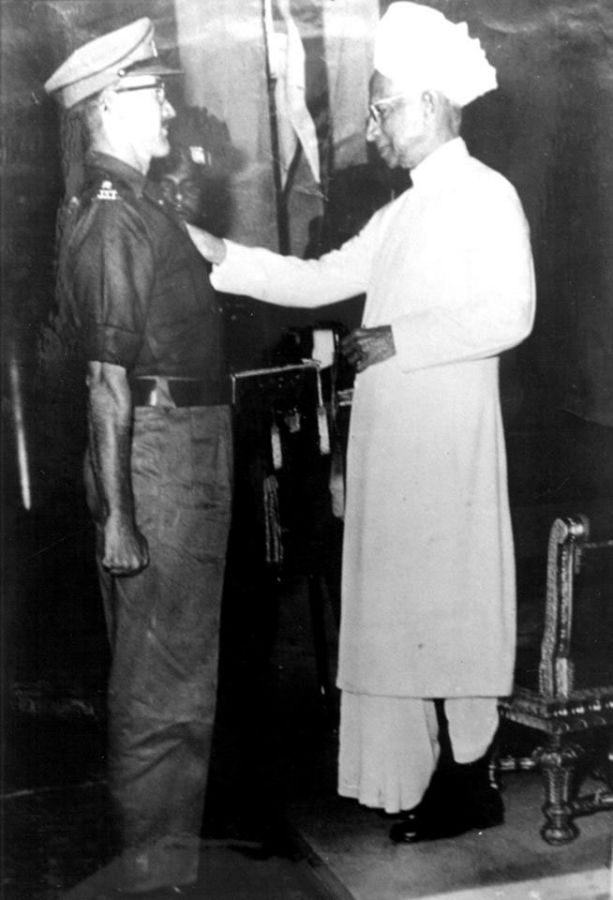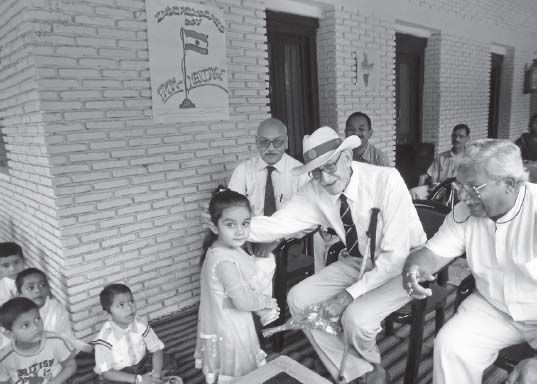Lieutenant Colonel Desmond Hayde was awarded the Mahavir Chakra, the second highest honour in war-time, for winning one of the toughest battles ever fought by the Indian Army.
In a brilliant and gruesome assault, what he and his men achieved that September 50 years ago, had never been seen before.
Archana Masih/Rediff.com salutes the maverick soldier's soldier.

In a cemetery in Bareilly, Uttar Pradesh, quietly rests a war hero that many may not know of -- a man born in Ireland, who led India in its bloodiest, yet finest, infantry battle in the 1965 Indo-Pak War.
It was an epic battle where 86 Indian soldiers died fighting a better fortified Pakistan army before the Indian flag could be raised in Dograi, on the outskirts of Lahore.
Led by Lieutenant Colonel Desmond E Hayde, whose Haryanavi was better than his clipped Hindi, the 3 Jat battalion of 550 men defeated an enemy which had double the number of soldiers.
They fought with guns, grenades, bayonets and bare hands, clearing every gulley, street, house and pill box (a concrete above-the-ground bunker) in an assault so courageous that it found its way into Haryanvi folklore.
For his personal courage and exemplary leadership, Lieutenant Colonel Hayde was awarded the Mahavir Chakra, the second highest honour in battle.

IMAGE: Lieutenant Colonel Hayde, who retired as a brigadier, painted by M F Husain. Photograph: Kind courtesy Indian Army Facebook Page
He is also perhaps the only soldier to be painted by the famed M F Husain on the battlefield. And it was during an address to his battalion, that Prime Minister Lal Bahadur Shastri, gave India one of its best known slogans 'Jai Jawan! Jai Kisan!
The colonel, who retired as a brigadier after 30 years in the Indian Army, bequeathed the Husain painting, along with his medal, citation and typewriter to the Jat Regiment that he loved so dearly.
When he died two years ago at 87, he was buried in a cemetery near the regiment's headquarters in Bareilly. Alongside him rests his wife Sheela, a Garhwali girl he had met in Bareilly as a young officer.
"He got a hero's farewell with full military honours. His regiment worshipped him," says Colonel Kunwar Ajay Singh, who knew him for more than thirty years.
"He was a maverick. One of those old style army officers who was in a different league. He felt that he had to work with his men and be with his men to be a leader of men."
 On the night of September 21, 1965 before his small battalion marched 8 kilometres from their trenches to Dograi, where the Pakistan army had entrenched itself, Lieutenant Colonel Hayde made only two demands of his men.
On the night of September 21, 1965 before his small battalion marched 8 kilometres from their trenches to Dograi, where the Pakistan army had entrenched itself, Lieutenant Colonel Hayde made only two demands of his men.
'Ek bhi aadmi pichhe nahin hatega! (Not a single man will turn back!)'
The second: 'Zinda ya murda, Dograi mein milna hai! (Dead or alive, we have to meet in Dograi!)
He warned his men against retreating. 'Even if all of you run away, I shall continue to stand on the battlefield alone,' Rachna Bisht Rawat writes in her must read book on the men and battles of the war -- 1965, Stories from the Second Indo-Pak War.
IMAGE: Lieutenant Colonel Hayde was the commanding officer of 3 Jat, one of the highest decorated regiments of the 1965 War. Photograph: Kind courtesy Indian Army Facebook Page
With just a single battalion, the daring commanding officer defeated the enemy battalion, which was supported by a tank squadron and one more battalion.
For what they accomplished that night, 3 Jat received three Mahavir Chakras, four Vir Chakras and seven Sena Medals.
"Brigadier Hayde never spoke about the Maha Vir Chakra or the Battle of Dograi. He thought of it as a job he had to do and he did it," says Colonel Singh, the managing director of a school which is run on the property bequeathed for the purpose by the brigadier in Kotdwar, Uttarakhand.
"He never even travelled on a free ticket that the government grants (for winners of gallantry medals). He was a rough, rugged, tough, guy for whom every day of life was the Indian Army."
Later this week, the school will be renamed Hayde Heritage. His three sons, one of whom retired as a lieutenant colonel from the Indian Army, will arrive from the UK and Canada to attend the ceremony.
The son of Anglo Indian parents whose father worked for the Railways, Brigadier Hayde's rules in life were very simple, and embibed from the motto the Indian Military Academy had sent him out with:
The country comes first, your men come second and self comes last.
"I have seen senior officers -- almost all have goals of self career progression -- but here was a man who had no iota of self," says Colonel Singh, who was encouraged and coached by Brigadier Hayde to join the Indian Army.
"That is the reason that even after he passed away in 2013, men from his regiment still call. He always thought of how the army and the lives of jawans could be improved, writing letters to the officials, the army chief, his own regiment etc."
Even in his 80s, if he was invited for an army function, he would call his gaadiwala (a hired car that he often used for outside travel) and set course.
Brigadier Hayde was no ordinary soldier, like so many other extraordinary men who fought so bravely in that month of September, 50 years ago.
Heroes like Havildar Abdul Hamid, Colonel A B Tarapore, Major Ranjit Dayal, Colonel Salim Caleb, Squadron Leader A B Devaiyya and many others -- men who need to be remembered but rarely are.
Ordered to breach the Ichogil canal, a deep and wide reservoir in Pakistan that ran parallel to the boundary, Colonel Hayde's battalion first took Dograi on the night of September 6-7.
It was for this action that he won the Mahavir Chakra, announced on the battlefield itself.
But 3 Jat had to fall back because rest of the units detailed to support them in the offensive, could not reach in time because of lack of information. Colonel Hayde and his men stood their ground alone till ordered by the brigade headquarters to retreat.
The miscommunication resulted in the removal of a major general, while 3 Jat had to wait in bunkers 8 kilometres behind enemy lines till they got the next orders for launching an assault on Dograi.
The wait was almost two weeks. By then Pakistan had converted Dograi into a fortress.

IMAGE: Lieutenant Colonel Hayde is awarded the Mahavir Chakra from President Dr S Radhakrishnan. Photographs: Kind courtesy Indian Army Facebook Page
It was in this scarred backdrop, that Colonel Hayde and his troops were given the task of re-taking Dograi. And they did -- company by company, combat by combat, inch by inch -- in a gruesome battle in which one fifth of the battalion was killed.
The death count on the opposite side was nearly 300.
In a blog post, many years later, an army officer referred to what Colonel Hayde had told a correspondent when asked what makes soldiers fight such gruesome wars.
'The colonel pointed to his second in command, Major Shekhawat and said: "Major Shekhawat fights because he holds nothing dearer than the respect and standing he enjoys in the eyes of his men, family, and community back home. His fear of losing that standing overcomes his fear of death."
"The men, of course, fight because Major Shekhawat fights."
Major Shekhawat retired as a colonel. He lost four of his fellow officers in Dograi that night.

After his retirement in 1978, Brigadier Hayde moved to Kotdwar in the Garhwal hills, his wife's hometown.
Till the end, he followed a very precise schedule. Having breakfast at 7 am, thereafter walking up to his study -- researching the history of the Jats, the 1965 and 1971 wars etc -- and eating supper by 7.30 pm.
"Our offices were adjacent," recalls Colonel Singh. "If I had to meet Brigadier Hayde, I had to take an appointment and I'll be damned if I was late even by a minute."
"He was a man who sought no popularity. He could be blunt and at times was not taken well. For him, there was no grey. Only black or white."
The brigadier set up the ex-servicemen league in Kotdwar and readily helped people from his paltan. He wrote a book on the Battle of Dograi and completed his memoirs, which is yet to be published.
"He used to come across as someone who was not too fond of kids or company, but started enjoying their presence on campus," says Colonel Singh.
"His other passion was stray dogs. He adopted so many of them. In fact 2, 3 of them would be in his bed."
The war hero remained a soldier right till his end, and battled skin cancer, like only a gallant fauji could. Sometimes, even surprising doctors with the way he went about life in spite of the virulent disease that was eating him away.
Exactly a month before he died, he circled September 25 on a calendar and hung it on the wall.
"He said, look September 25th will be my last day and I told him, 'Sir, what nonsense are you speaking'," Colonel Singh recalls.
"But he was absolutely right."
Two days after after winning one of Indian Army's toughest battles on September 23, 1965, the hero of Dograi passed away 48 years later.
There will be a ceremony to commemorate Brigadier Desmond Hayde and the golden jubilee of the 1965 war in Kotdwar this week. It will be worth our while that we salute this authentic Indian hero and the brave Indian soldiers who fought the Battle of Dograi, wherever we are.
OUR SPECIAL SERIES: THE 1965 WAR, 50 YEARS LATER
- Asal Uttar, the battle that turned the tide of the 1965 war
- Param Vir Chakra Abdul Hamid, a Hero's Hero
- My Father, the Param Vir Chakra Winner
- The daredevil fighter pilot who survived a Pakistani bullet
- My salute to arguably India's greatest military hero
- Two wars and a romance
- The war that helped India regain its military confidence
- The central lesson from the '65 war
- The general who saved Punjab in the '65 war










